Juniper Trees and Shrubs: Types, Leaves, Berries (With Pictures) – Identification Guide

Juniper trees and shrubs are a group of evergreen conifers with needle-like leaves that have a pine scent and dark-blue berry-like aromatic fleshy cones. Species of juniper trees vary in shape and they grow between 66 and 103 ft. (20 – 40 m) tall. However, junipers can also grow as low-growing, spreading shrubs growing as little as 1 ft. (0.3 m) or as tall as 5 or 6 ft. (1.5 – 1.8 m). Junipers also grow in many climates and can withstand freezing temperatures.
Junipers are popular landscaping evergreen plants for gardens. Columnar juniper trees are excellent for growing as hedges or specimen plants. In addition, juniper shrubs and creeping juniper plants are ideal as foundation plantings, growing in containers on a patio or deck, or as ground cover. Regardless of the type of conditions in your garden, you can grow junipers in USDA zones 2 through 9.
Juniper trees and shrubs belong to the genus Juniperus in the coniferous plant family Cupressaceae.
This article is a guide to the best juniper evergreen shrubs and trees for your garden landscape. Descriptions and pictures of juniper trees and shrubs will help you choose the best plants to add year-long greenery to your yard.
Juniper Trees vs. Juniper Shrubs
The only difference between juniper trees and shrubs is the plant height. Some juniper cultivars like California juniper (Juniperus californica) are classed as shrubs because of their dwarf size and low-growing habit. Other junipers are more difficult to classify because they grow as small trees or large shrubs.
For example, the common juniper (Juniperus communis) can grow as a small creeping shrub that spreads up to 12 ft. (3.6 m), or it can be a small tree growing up to 33 ft. (10 m) tall. Or Chinese juniper ‘Hetzii’ grows around 5 ft. (1.5 m) tall, and some people classify it as a large shrub, whereas other put in the small tree class.
Juniper Tree Leaves
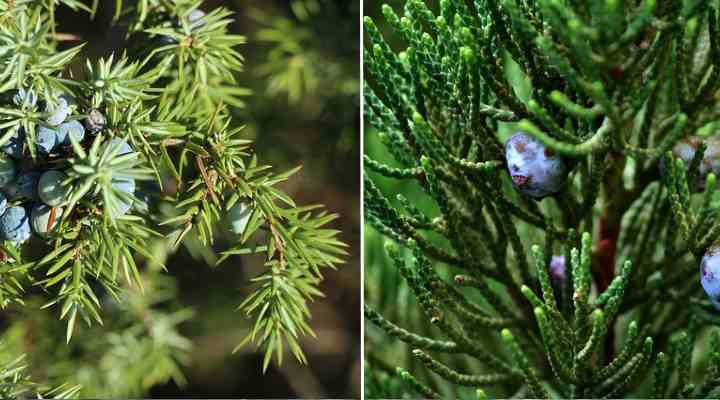
Juniper evergreen leaves can be needle-like or feathery
Like all conifers, junipers have identifiable evergreen needle leaves or scaly feathery leaves. Sharp, prickly needle leaves identify immature juniper trees and shrubs and typically grow in whorls of three and measure 0.2 – 1” (0.5 – 2.5 cm). In addition, mature junipers have soft scale leaves that look more like arborvitae tree leaves.
However, some juniper trees and shrubs—like the common juniper (Juniperus communis) and ‘Blue Star’ juniper (Juniperus squamata)—have prickly needles throughout their life. Therefore, this feature of common juniper leaves is a helpful identifying characteristic.
Juniper leaves are an easy way to identify species of junipers before they mature. Unlike cypress trees and shrubs, immature juniper foliage tends to be spiky and sharp. On the other hand, immature cypress trees have soft, scaly leaves.
When crushed, juniper leaves give off a resinous, slightly citrusy aroma that some say is reminiscent of cedar foliage, apples, or incense.
Juniper Tree Cones
Juniper cones on male trees are small yellowish or brownish-tan in color with 6 – 20 scales. They are located at the tips of the foliage and look more like swelling on the ends of the leaves.

Juniper male cones on California juniper tree
Juniper cones on female trees are fleshy, berry-like growths with a bitter taste. The cones are green “berries” when immature and ripen to purple-black color. Juniper cones typically measure 0.15” to 0.5” (0.4 – 1.2 cm) in diameter and take up to two years to mature.
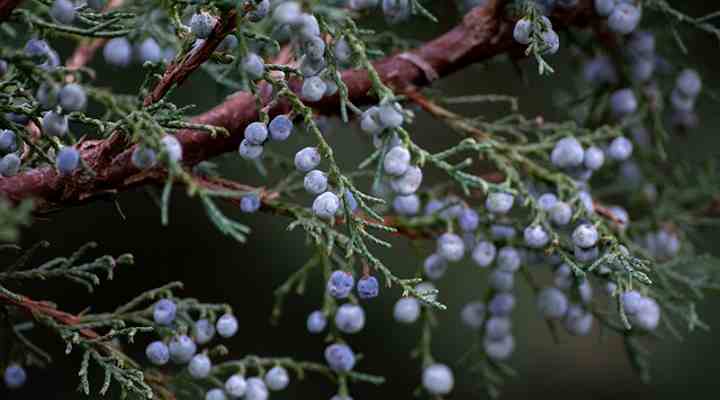
Female juniper trees produce berry-like cones
Juniper tree cones are unusual compared to other conifers. The modified cones are made up of tiny scales that don’t become woody like pine cones. Instead, the scales stay fleshy and eventually fuse and develop into “berries.”
The small round green or dark purple cones on juniper trees and shrubs grow among the needle-like foliage. The colorful cones give juniper trees an appealing quality in garden landscapes where they stay on the tree or shrub throughout the year.
Juniper Berries
Juniper berries are the edible green or purplish-black fleshy cones that grow on juniper trees. Green berry-like juniper cones have a piney citrus taste. Mature purple Juniper berries are used to flavor European and Scandinavian cuisine. Berries from the common juniper (Juniperus communis) are used to flavor gin.
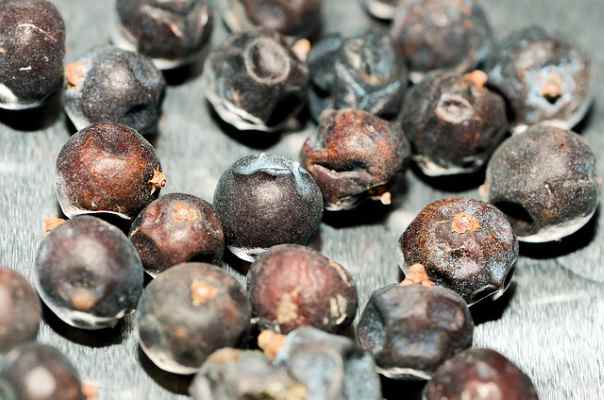
Dried juniper berries. Not all juniper berries are safe to consume
Although berries from most species of juniper trees are safe to consume, some species produce poisonous berries. For example, toxic juniper berries grow on the plants Juniperus sabina and Juniperus oxycedrus.
Juniper shrubs producing edible berries are the common juniper (Juniperus communis), California juniper (Juniperus californica), Syrian juniper (Juniperus drupacea), and alligator juniper (Juniperus deppeana). So, unless you are sure of the juniper species, it’s best to avoid consuming juniper berries straight off the tree.
Juniper berries have a strong, bitter taste with a slightly spicy flavor. Because of their intense flavor, juniper berries from the common juniper shrub are usually used in small quantities. Culinary uses for juniper berries include flavoring meat dishes, using in marinades, or adding to wood chips when smoking meat.
Juniper Tree Bark
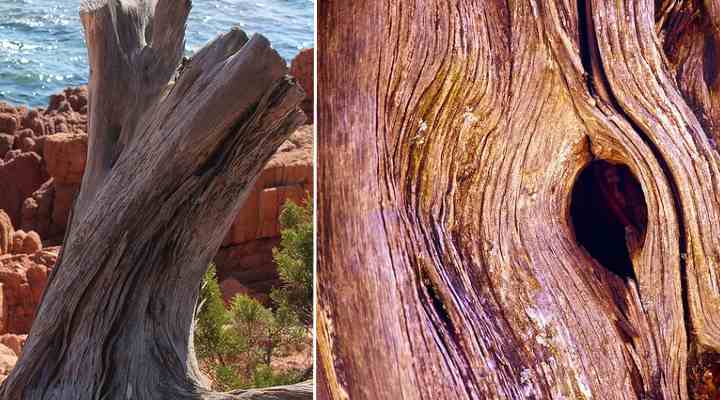
Juniper tree bark
Juniper tree bark is typically reddish-brown, and it peels off in thin, vertical strips or plates. One identifying feature of juniper trees is their highly aromatic bark that gives off a woody, cedar smell. In addition, some juniper trees have distinctive bark. For example, the alligator juniper (Juniperus deppeana) has checkered bark that looks like alligator skin.
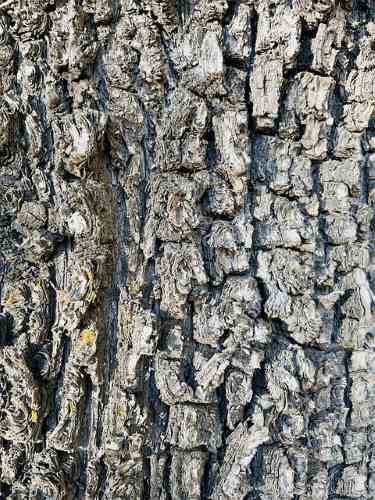
Alligator juniper bark
Do Juniper Trees Have Flowers?
Juniper trees don’t bloom or produce actual flowers. Instead, the juniper “flowers” are modified leaves (bracts) that appear or “bloom” from late winter until early spring. The flower bracts then fuse to develop into cones or juniper fruits. The “flowers” on female juniper trees can be particularly showy.
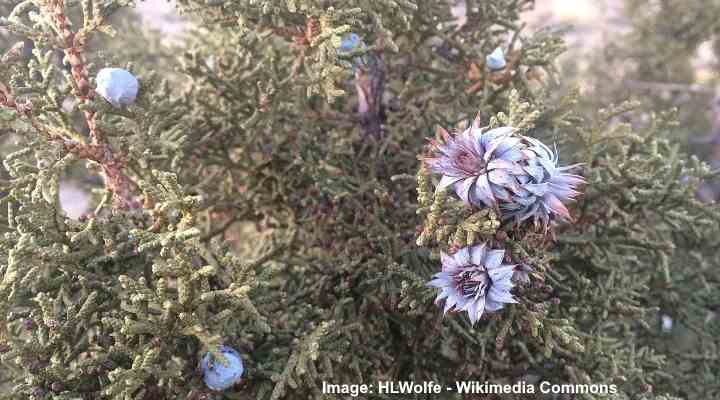
Juniper female “flowers”
How to Identify Juniper Trees
The best way to identify junipers is by the prickly needle-like leaves on immature juniper trees and bushes. Junipers also have distinctive berry-like cones that help tell junipers apart from other coniferous trees. Juniper trees and shrubs have an identifiable citrus aroma when the leaves or bark are crushed.
Types of Juniper Trees (With Pictures)
Let’s look in more detail at the most popular species of juniper trees and landscaping shrubs that are suitable for growing in gardens.
Common Juniper (Juniperus communis)
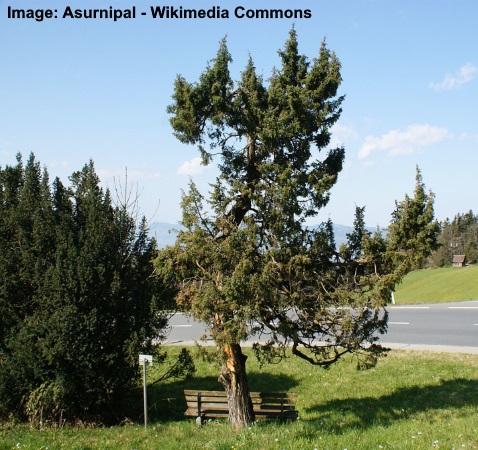
Common juniper (Juniperus communis)
The common juniper is a tall evergreen tree, however some cultivars are low-growing columnar trees or spreading shrubs. The common juniper has prickly needle foliage, dark blue fleshy cones, and yellow spring “flowers.” As a low, mat-forming shrub, the common juniper cultivars grow 5 ft. (1.5 m) tall and up to 13 ft. (4 m) wide.
Common juniper trees are one of the most popular trees in the world. The popular tree grows up to 25 ft. (7.5 m) tall and spreads up to 12 ft. (3.6 m). The evergreen tree is ideal for growing as a hedging plant to create a privacy screen, living fence, or barrier.
Other attractive juniper landscaping plants include the following small or dwarf cultivars:
Common Juniper ‘Gold Cone’ (Juniperus communis ‘Gold Cone’)—The ‘Gold Cone’ dwarf juniper cultivar is a beautiful landscaping tree with dense gold-green foliage. With its upright, columnar shape, the slow-growing juniper looks great as a specimen tree, foundation planting, or container tree. The juniper ‘Gold Cone’ grows 3 to 5 ft. (1 – 1.5 m) tall and up to 2 ft. (0.6 m) wide.
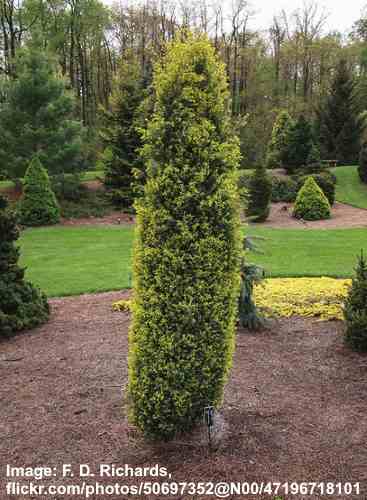
Juniperus communis ‘Gold Cone
Dwarf Pencil Point Juniper (Juniperus communis ‘Compressa’)—A columnar shrub-like tree with blue-green evergreen foliage that turns an attractive copper color in the fall. Grows 3 ft. (1 m) tall and 2 ft. (0.6 m) wide. Ideal as an accent plant, front of house plant, or patio container plant.

Juniperus communis ‘Compressa’
Blueberry Delight Juniper (Juniperus communis ‘AmiDak’)—This miniature shrub is a low-growing creeping juniper plant with dark-green leaves and contrasting silvery-blue hues that keep their color in fall and winter. The name of this spreading juniper cultivar ‘blueberry’ comes from the blue-colored berries that appear in the fall. Grows 2 ft. (0.6 m) tall and up to 10 ft. (3 m) wide. This hardy evergreen shrub thrives in USDA zones 2 to 6.
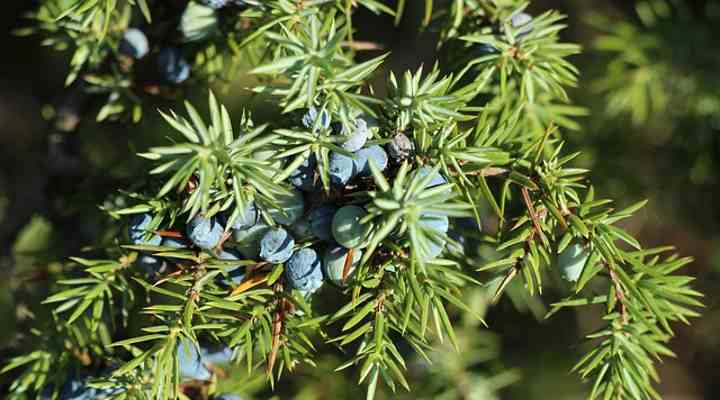
Juniperus communis ‘AmiDak’
Juniper Identification: The common juniper is easy to identify because its spiky needle-like leaves don’t become soft and scaly like most other types of juniper. Also, small dark blue berry-like cones cover the plant in the fall.
Chinese Juniper (Juniperus chinensis)
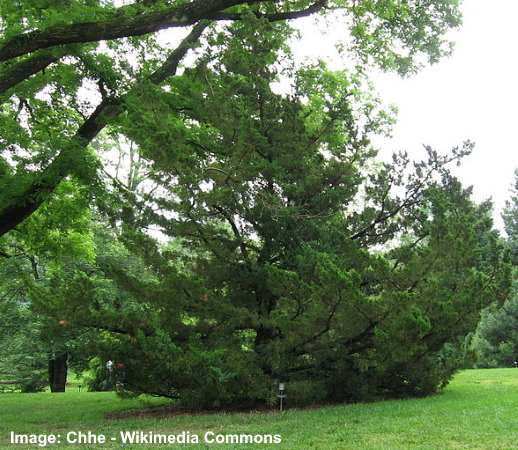
Chinese juniper (Juniperus chinensis)
The Chinese juniper is an ornamental evergreen tree or large shrub. The Chinese juniper is identified by spiky, needle-like leaves growing up to 1” (2.5 cm) long on immature plants. Like most junipers, the Chinese juniper has dark blue fleshy cones with a white waxy covering.
Chinese junipers grow between 3 and 65 ft. (1 – 20 m) tall, depending on the climate. The coniferous evergreen tree/shrub is ideal for growing in residential gardens. Its dense dark green foliage creates perfect privacy screens. Or you can trim the foliage to grow shrubs for foundation plantings, containers, or a specimen plant.
Other impressive Chinese juniper landscaping trees include the following:
Juniperus chinensis ‘Expansa Variegata’—This spreading, slow-growing juniper shrub only grows 6” to 12” (15 – 30 cm) a year and takes ten years to grow 5 to 10 ft. (1.5 – 3 m) tall. The variegated juniper has yellow and green spiky leaves.
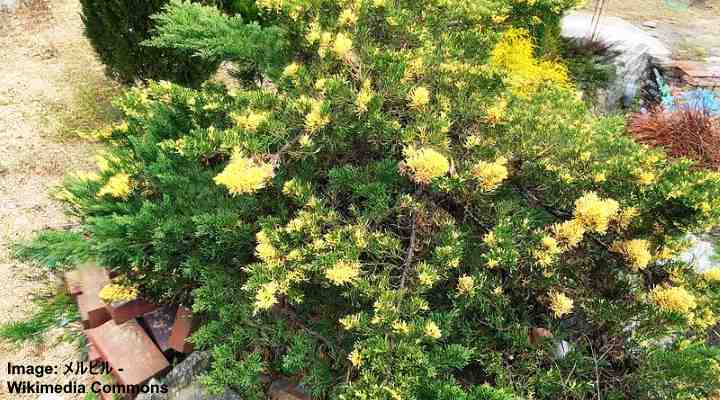
Juniperus chinensis ‘Expansa Variegata’
Spartan Juniper Tree (Juniperus chinensis ‘Spartan’)—This juniper is a columnar tree with pencil-like growth. The mature juniper tree cultivar ‘Spartan’ grows 20 ft. (6 m) tall and 5 ft. (1.5 m) wide.
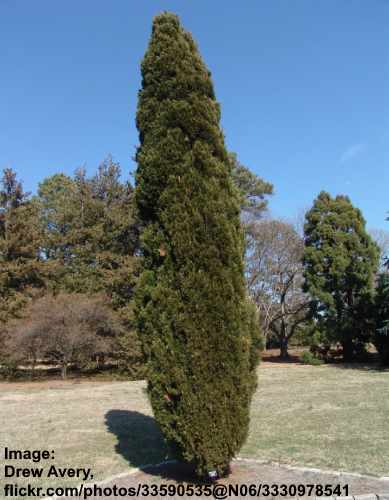
Juniperus chinensis ‘Spartan’
California Juniper (Juniperus californica)
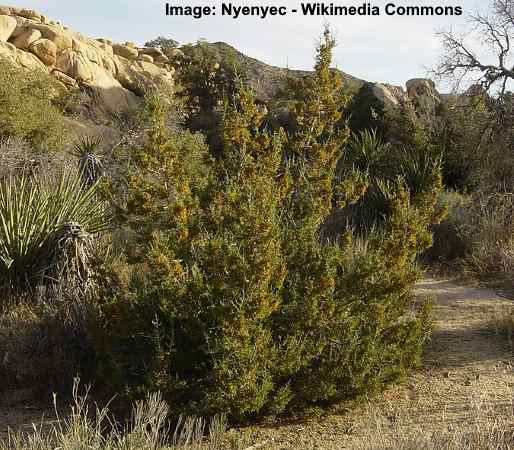
California juniper (Juniperus californica)
The California juniper is a native shrub-like juniper tree identified by scaly green-gray leaves, dark blue-brownish fleshy cones, and thin peeling bark. The short scaly leaves on mature plants grow 0.2” (0.5 cm) long. Like all junipers, the evergreen leaves are stiff and prickly on immature shrubs.
Also called the juniper Joshua tree, the California juniper tree grows 10 to 26 ft. (3 – 8 m) tall. The berry-like cones are dark blue with a white coating and measure 0.5” (1.3 cm) diameter.
The California juniper is related to another native juniper plant, the Utah Juniper (Juniperus osteosperma). The Utah juniper is more tolerant of cold than the California juniper, but its “berries” take longer to mature.
Juniper identification: The California juniper is identified by its bluish “berries,” soft, scaly foliage, and thin peeling bark that appears shredded.
Utah Juniper (Juniperus osteosperma)
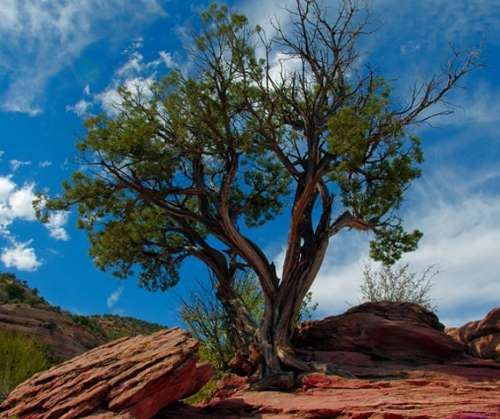
Utah Juniper (Juniperus osteosperma)
Utah juniper is a small evergreen tree or a shrub that grows 15 – 30 ft. (4.5 – 9 m) tall and native to the southwestern United States. It grows on dry, rocky soil or mountain slopes, and is the most common juniper species in Utah and Arizona. Utah juniper has rounded crown with spreading branches and gray-brown or whitish-gray bark peeling in long thin stripes.
The green young leaves of Utah juniper are needle-like, 0.2 – 0.4″ (5–10 mm) long, and the mature leaves are very short scale-like, 0.04 – 0.08″ (1 – 2 mm) long. The berry-like cones are bluish-brown with white coating and measure 0.3–0.5” (8 – 13) mm in diameter.
Utah juniper is hardy to USDA zones 3 – 8 and is a drought tolerant tree/shrub.
Juniper identification: Utah juniper is a medium sized tree with blue-brown “berries”, very short scale-like mature leaves and a bark that peels in thin stripes.
Skyrocket Juniper Tree (Juniperus Scopulorum ‘Skyrocket’)
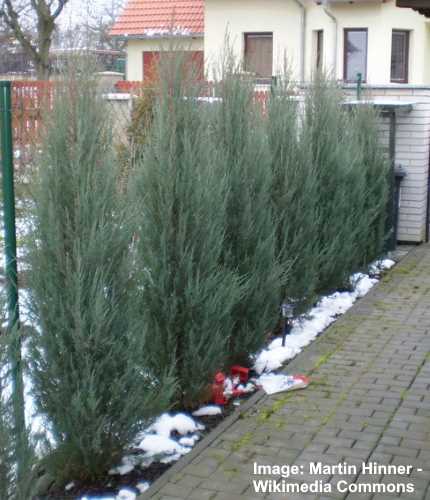
Skyrocket juniper tree (Juniperus Scopulorum ‘Skyrocket’)
The ‘Skyrocket’ juniper tree is a columnar juniper that is perfect to create a visual accent in a garden landscape. The narrow, columnar juniper is identified by its scale-like aromatic leaves that are a bluish-green color. The juniper has identifiable thin, reddish-brown peeling bark and bluish-gray berry-like cones.
The ‘Skyrocket’ is one of the narrowest juniper trees for garden landscapes. It’s a slow-growing juniper with vertical growth and attractive foliage. Columnar ‘Skyrocket’ junipers eventually grow up to 20 ft. (6 m) tall with a spread of 3 to 12 ft. (1 – 4 m).
Juniper identification: The ‘Skyrocket’ juniper (Juniperus scopulorum) is identified by its shedding reddish-brown bark, soft scaly foliage, and tall, narrow, columnar appearance.
Mexican Juniper (Juniperus flaccida)
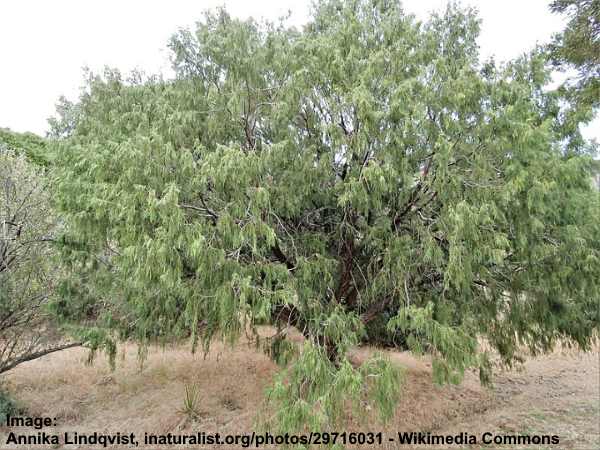
Mexican Juniper (Juniperus flaccida)
The Mexican juniper is a weeping juniper tree with drooping branches, flattened green sprays, brown berry-like cones, and thin cinnamon-brown bark that peels off in thin strips. Also called the drooping juniper, the Mexican juniper tree grows between 16 and 33 ft. (5 – 10 m) tall and 33 ft. (10 m) wide.
Mexican juniper fruits are large berry-like fleshy cones that measure up to 0.8” (2 cm) in diameter.
Juniper identification: The weeping Mexican juniper is the only specimen tree with flattened spray foliage growing on pendulous branches.
Other Types of Juniper Trees for Landscaping Gardens
The most popular landscape junipers are the elegant common juniper with its characteristic dark blue berries, and the ‘Blue Star’ juniper dwarf shrub. Let’s look briefly at other juniper trees for front or backyards:
Ashe Juniper or Mountain Cedar (Juniperus ashei)—This juniper has feathery foliage that is bright green, soft berry-like purple cones, and peeling brown bark. Also called the blueberry juniper, this native juniper grows up to 33 ft. (10 m) tall.
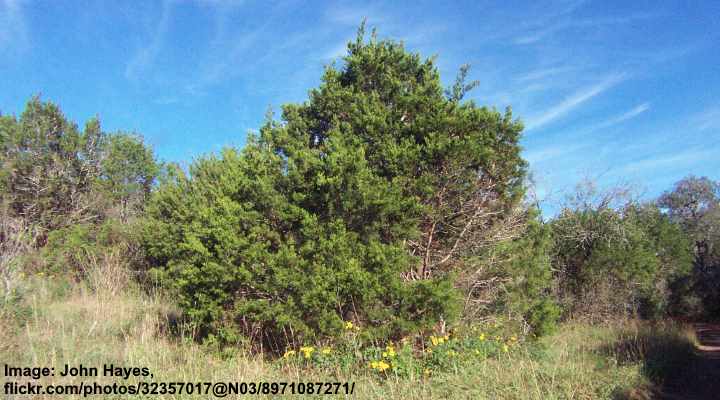
Ashe Juniper or Mountain Cedar (Juniperus ashei)
Virginian Juniper (Juniperus virginiana)—This vast columnar juniper tree has feathery, scale-like blue-green or gray-green leaves and masses of dark blue-black “berries.” Also called the eastern red cedar, the Virginian juniper grows 40 to 50 ft. (12 – 15 m) tall and 8 to 20 ft. (2.4 – 6 m) wide.
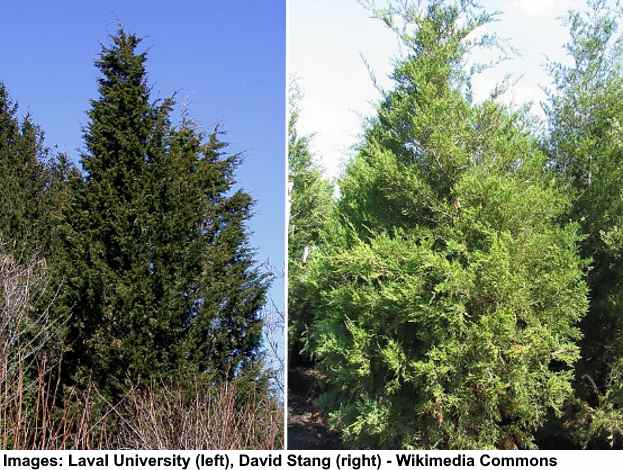
Virginian Juniper/Eastern Red Cedar (Juniperus virginiana)
Brodie Juniper (Cupressaceae juniperus ‘Virginiana Brodie’)—Its botanical name indicates that the Brodie juniper is a type of cypress tree. The fast-growing, drought-tolerant tree has rich green soft, scaly foliage and a pyramidal, columnar shape. The Brodie juniper grows 15 to 20 ft. (4.5 – 6 m) tall and up to 15 ft. (4.5 m) wide.
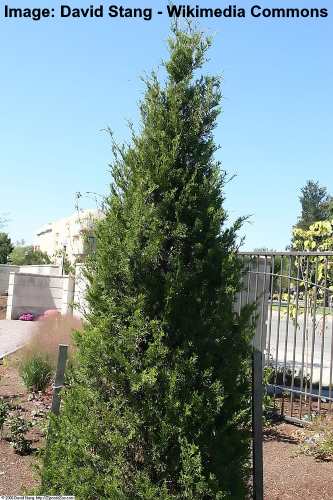
Brodie Juniper (Cupressaceae juniperus ‘Virginiana Brodie’)
Types of Juniper Shrubs (With Pictures)
Low-growing juniper shrubs have many landscape uses. The dwarf or short-stature spreading evergreen junipers are ideal for ground cover, foundation planting, rock gardens, or evergreen borders.
Here are some of the best examples of juniper shrubs:
Blue Star Juniper (Juniperus squamata ‘Blue Star’)
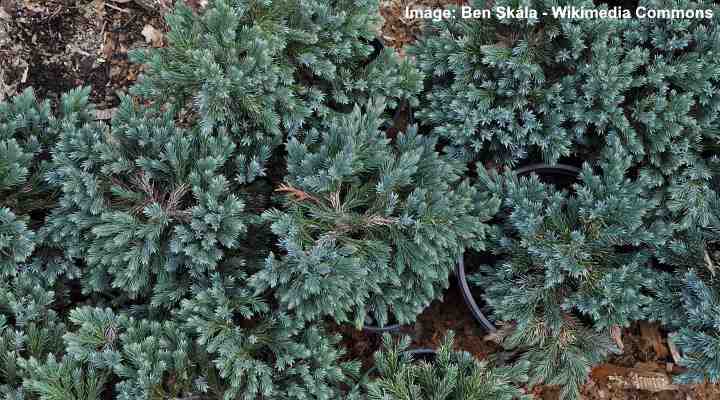
Blue Star Juniper (Juniperus squamata ‘Blue Star’)
The ‘Blue Star’ juniper shrub has a spreading habit and doesn’t grow taller than 3 ft. (1 m) tall and 4 ft. (1.2 m) wide. The ‘Blue Star’ cultivar has prickly silvery-blue needle leaves that form a dense mat as the creeping branches spread. ‘Blue Star’ junipers are easy to grow in landscapes.
The ‘Blue Star’ juniper is ideal for bushy ground cover in full sun in a garden landscape. The compact, mounding plant is also suitable as a foundation plant, container plant, or evergreen foliage in rock gardens.
Like all juniper cultivars, the ‘Blue Star’ juniper is a drought-tolerant shrub once established. In addition, the low-maintenance evergreen shrub doesn’t require any pruning to keep its shape.
- Blue Star Juniper ‘Meyeri’ (Juniperus squamata ‘Meyeri’)—This ‘Blue Star’ juniper cultivar is an upright bushy shrub with steel-blue foliage. Grows up to 5 ft. (1.5 m) tall and 4 ft. (1.2 m) wide.
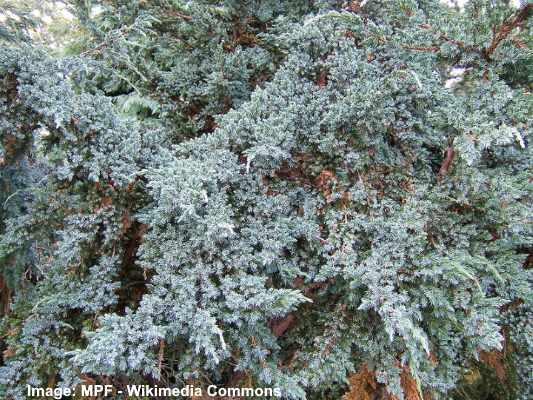
Juniperus squamata ‘Meyeri’
Blue Pacific Shore Juniper (Juniperus conferta ‘Blue Pacific’)
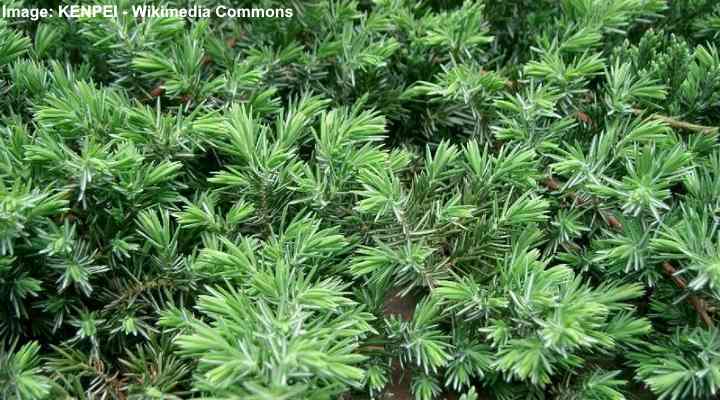
Blue Pacific Shore juniper (Juniperus conferta ‘Blue Pacific’)
The ‘Blue Pacific Shore’ juniper is an attractive spreading plant with dense foliage, perfect for full-sun ground cover. The dark green needle-like leaves become softer as the low-growing juniper matures. The ‘Blue Pacific’ juniper grows 1 ft. (0.3 m) tall and up to 7 ft. (2.1 m) wide.
Wichita Blue Juniper (Juniperus scopulorum ‘Wichita Blue’)
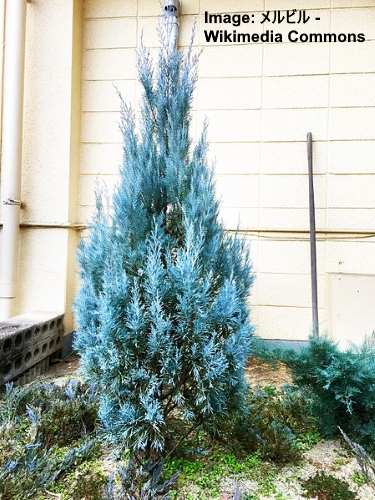
Wichita Blue juniper (Juniperus scopulorum ‘Wichita Blue’)
The ‘Wichita Blue’ juniper is a native ornamental plant with an attractive conical shape, ideal as a hedging plant. Its silver-blue dense foliage and broadly pyramidal form are the identifying features of the ‘Wichita Blue’ juniper shrub. This hardy juniper shrub grows 10 to 15 ft. (3 – 4.5 m) tall and up to 6 ft. (1.8 m) wide.
Dwarf Japanese Garden Juniper (Juniperus procumbens ‘Nana’)
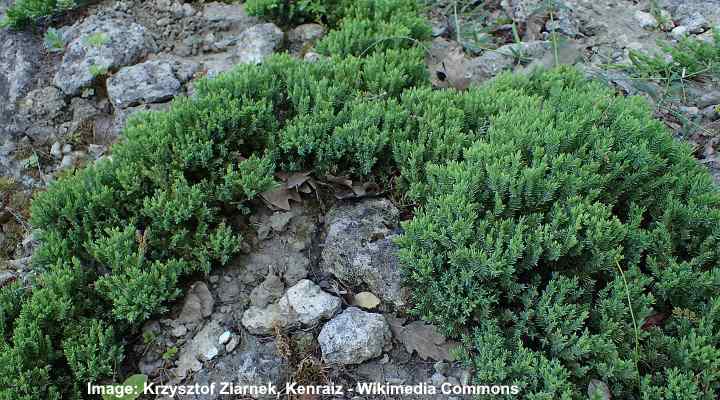
Dwarf Japanese garden juniper (Juniperus procumbens ‘Nana’)
The dwarf Japanese garden juniper is an ornamental shrub suitable for ground cover, planting on sunny slopes, or under the window as a foundation planting. The spreading juniper branches have spiky blue-green needle leaves, and the dense foliage keeps its attractive appearance all year long.
As one of the shortest juniper shrubs, the dwarf Japanese garden juniper plant grows up to 1 ft. (0.3 m) tall and 6 ft. (1.8 m) wide.
Creeping Juniper (Juniperus horizontalis)
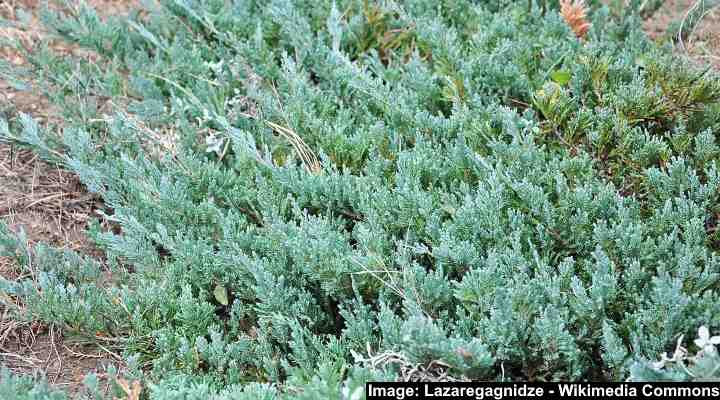
Creeping juniper (Juniperus horizontalis)
The creeping juniper is a native North American juniper shrub with green-gray, feathery, scaly leaves and low, spreading growth. This sprawling juniper shrub doesn’t grow taller than 12” (30 cm) tall. However, it spreads up to 10 ft. (3 m), creating a soft mat of evergreen foliage.
In cultivated landscapes, the low-growing creeping juniper rarely produces its characteristic blue fleshy cones.
Blue Chip Juniper (Juniperus horizontalis ‘Blue Chip’)
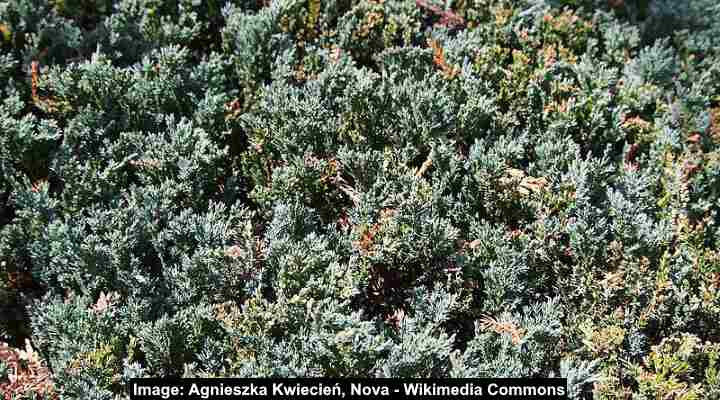
Blue Chip juniper (Juniperus horizontalis ‘Blue Chip’)
The ‘Blue Chip’ juniper shrub is a spreading plant with long creeping branches that stretch up to 8 ft. (2.4 m) long. The ‘Blue Chip’ juniper is identified by its silvery-blue soft needle-like leaves and densely growing foliage. Grow to create evergreen edging along paths or driveways or durable ground cover.
Related articles:
